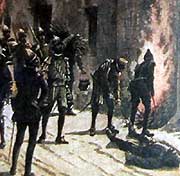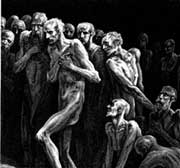The Dark Age of Valencia
Conflict, Plagues and Persecution
16th - 17th century
 Over
the course of the XVI century the economy of Valencia moved step-by-step
towards decline. The 1519-1522 saw an all out civil war between the nobles
and the emboldened guilds, cripling the economy severely. The Spanish
Crown had to take over the situation and create an office of viceroy to
supress the conflict and establish a permanent Royal hand in the city. Over
the course of the XVI century the economy of Valencia moved step-by-step
towards decline. The 1519-1522 saw an all out civil war between the nobles
and the emboldened guilds, cripling the economy severely. The Spanish
Crown had to take over the situation and create an office of viceroy to
supress the conflict and establish a permanent Royal hand in the city.
However, it was also the age of Rennaisance, and Valencia was one of
the first to catch the trends, due to its close ties with Italy via the
Borgia. The new Literary Univeristy opened, as well as other educational
institutions, the viceroy court surrounded itself with the new ideas and
the humanism flourished. Valencia was at the cutting edge of Rennaisance
on the Iberic Peninsula, leading in many ways. They say, for example,
that the printing press - this ultimate vehicle of modernisation of the
times - entered Spain through Valencia.
But the Rennaisance in Valencia didn't quite become a new engine for
liberal growth. The Catholic Church launched a Counter-Reformation against
the Protestant movements and Valencia became one of the battlefields.
Patriarch Juan Ribera became a saint for doing a particularly good job
with Inquisition and censorship. An exaggerated cult of traditional Catholicism
took over Valencia, eventially leading to animosty towards the Moors still
residing there.
 This
animosity, plus the recurrent attacks on the coasts by Berber pirates,
led to the Final Solution in the beginning of the XVII century - to expel
all the Moors from Valencia, dealing a fatal blow to the city, since much
of the agrigulture and the local economy was resting on the shoulders
of the Moorish population. This
animosity, plus the recurrent attacks on the coasts by Berber pirates,
led to the Final Solution in the beginning of the XVII century - to expel
all the Moors from Valencia, dealing a fatal blow to the city, since much
of the agrigulture and the local economy was resting on the shoulders
of the Moorish population.
The XVII century was another Dark Age of Valencia. Severely crippled
economically by the expulsion of the Moors, ravaged by a particularly
bad epidemic of the Black Death in 1647, engulfed by the religious hysteria
of pompous Baroque Counter-Reformation (this is when Corpus
Christi came into its full glory), it kept skipping from one bloody
popular mutiny to another. It is in this schizophrenic state that Valencia
found itself involved into the War of Succession.
Sights from the period:
Basilica de los Desamparados
| College
of San Pio V | Church
of Santa Maria del Mar | Plaza
del Patriarca | Monastery
San Miguel de los Reyes | Santo
Domingo Convent
Map: Location of 16th-17th
century Valencia
|